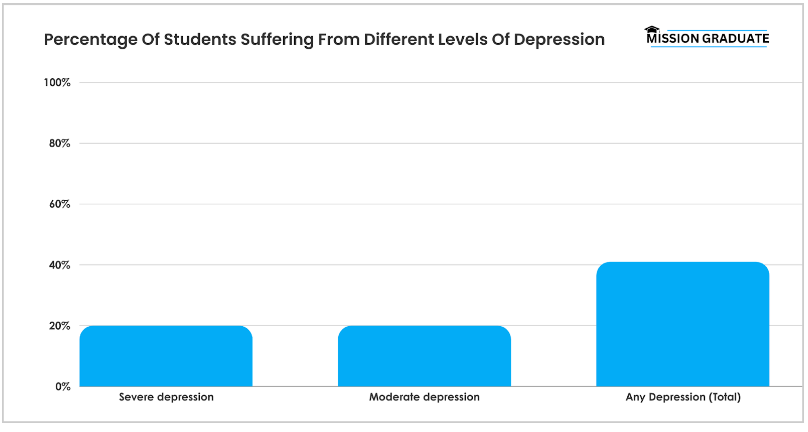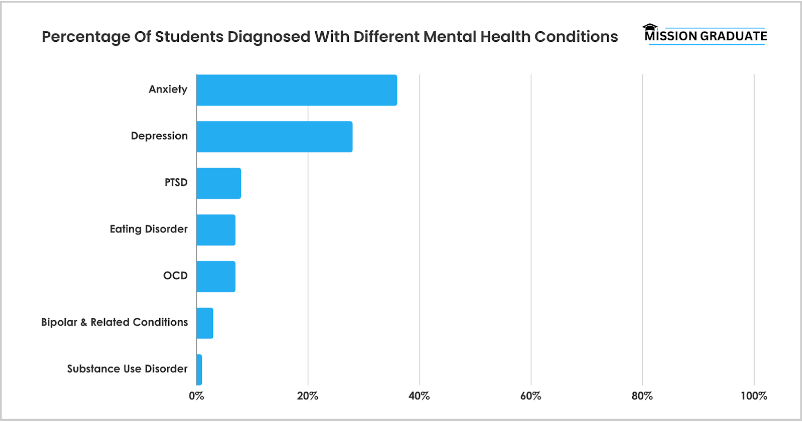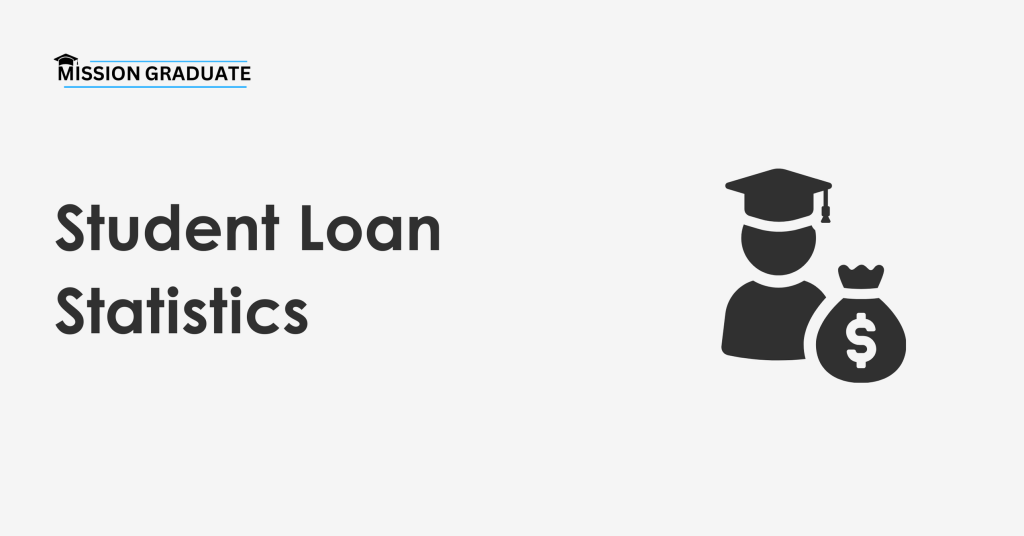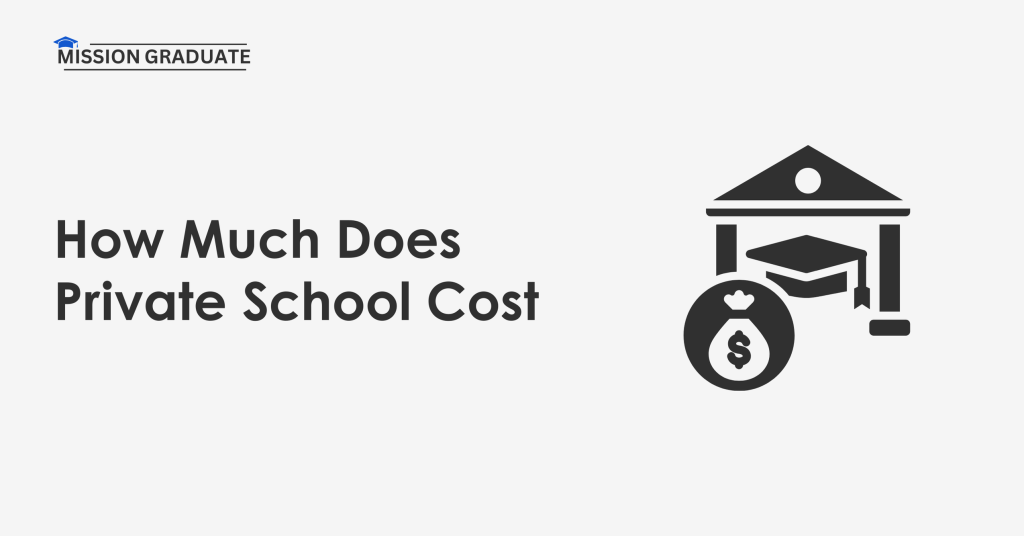While entering college, students have numerous expectations, and stress accompanies these expectations. Some students also have a hard time adjusting to new environments and new places and may experience homesickness and anxiety.
However, at times, external factors like teasing, bullying, or harassment may also lead to depression.
Today, over 4 in 10 college students witness the symptoms of depression in the United States. Meanwhile, 2 in 10 college students fall victim to severe depression.
Let’s take a closer look at the facts and figures about depression in college students, the impact of depression on students, the leading causes of depression, common symptoms, the share of affected students seeking help, demographics of college students suffering from depression, and more.
College Students And Depression Statistics: Top Picks (2025)
- In the academic year 2022-23, 41% of the students experienced symptoms of depression.
- During Spring 2023, 22% of the college students stated that depression has negatively impacted their academic performance in the last 12 months.
- Around 52% of college students reported experiencing stress due to the challenges faced in their academics during Spring 2023.
- 80% of the students reported feeling hopeless, depressed, or feeling down.
- 75% of the students suffering from depression do not seek help.
- 77% of the students suffering from depression sought help from a healthcare professional within the last 12 months during 2023 spring.
- 57% of the Trans/ Gender-Non-Conforming college students reported facing depression in Spring 2023.
- Most Black College (29.6%) students suffered from depression.
How Many College Students Have Depression?
41% of the students experienced symptoms of depression in the United States in 2022-2023.
A survey of college students conducted in the years 2022-2023 in the United States highlighted that 20% of the students had severe symptoms of depression, while 20% of the students had moderate symptoms of depression.
The symptoms of depression vary among college students. Still, the most common ones recorded are loss of interest in things that the student enjoyed earlier, feelings of hopelessness and sadness, changes in sleep, thoughts of death or suicide, fatigue, etc.
The following table displays the percentage of college students with symptoms of depression in the United States as of the year 2022-2023.

| Depression Severity | Percentage Of Students |
| Severe depression | 20% |
| Moderate depression | 20% |
| Any Depression (Total) | 41% |
Source: Statista, Healthy Mind Study.
44% of the college students reported symptoms of depression in academic year 2021–22.
In an annual survey of 96,000 U.S. students across 133 campuses during the 2021–22 academic year, it was found that 44% of the college students reported symptoms of depression.
At the same time, 37% of the students reported that they experienced anxiety, and 15% stated that they had seriously considered suicide.
The survey further revealed that 37% of the students had received mental health counseling during the 2021–22 academic year. That was a 7% increase from 2020.
Additionally, the rate of binge drinking also declined among the students compared to the previous years. 54% of the students in the survey stated that they did not consume any alcohol in the past two weeks, while 17% consumed alcohol but did not binge drink in the past two weeks.
Source: National Center on Safe Supportive Learning Environments.
Impact Of Depression On Students
22% of the college students stated that depression has negatively impacted their academic performance in the last 12 months.
Meanwhile, 5% of the students reported a delay in their progress toward their degree due to depression.
At the same time, nearly one-third of college students were diagnosed with depression that led to mood disorders in Spring 2023.
Depression usually impacts the feelings, thoughts, and behavior of college students. Apart from that, it decreases the ability of the students to function efficiently. As a result, their productivity in life decreases.
Source: American College Health Association.
What Are The Leading Causes Of Depression In College Students?
Some of the leading causes of depression in college students are academic pressure, isolation, discrimination, harassment, and other stresses.
Here are some facts and figures related to these leading causes of depression and other mental health issues in college students.
Around 52% of college students reported experiencing stress due to the problems or challenges they faced in their academics during Spring 2023.
Of these, 88% of students stated that these problems and challenges have caused moderate or high levels of distress.
Source: American College Health Association.
Nearly one-fourth of the students felt isolated in the academic year 2022-23.
At the same time, 19% of the college students felt a lack of companionship, while 22% reported that they often felt left out in college.
The following table displays the percentage of students who experienced the symptoms of loneliness and isolation by frequency in the academic year 2022-23.
| Symptoms of loneliness | Experienced Often | Experienced Some of the Time | Experienced Hardly ever |
| Isolated from others | 25% | 36% | 29% |
| Feeling Left Out | 22% | 39% | 29% |
| Lacking Companionship | 19% | 37% | 34% |
Source: Healthy Minds Network.
19% of the college students reported facing microaggressions in the past 12 months.
Microaggressions are a form of discrimination that creates fear among students of color, race, LGBTQ+, and other underrepresented students and makes them feel unsafe on campus.
Further, according to the survey conducted in spring 2023, 12% of college students experienced discrimination in the past 12 months, and another 12% reported being sexually harassed.
7% stated that they were a victim of bullying, while around 3% stated experiencing cyberbullying, and 1% reported that they had faced hazing in the past 12 months.
Source: American College Health Association.
Nearly half of the transgender college students and gender-non-confirming students had experienced microaggressions.
In the Spring 2023 survey, 46% of the transgender and gender-non-confirming college students reported facing microaggressions in the past 12 months.
Besides, 28% of the transgender students experienced discrimination, and 21% of the students experienced sexual harassment.
Source: American College Health Association.
Here are some of the most common causes of depression among college students:
- Academic pressure.
- Peer pressure.
- Poor Financial Conditions.
- Harassment, discrimination, and bullying
- Moving away from home for studies.
- Lack of physical activity and poor eating habits.
- Family history of depression
What Are The Most Common Symptoms Of Depression?
Feeling hopeless, depressed, or feeling down were the most common symptoms of depression among college students. 80% of the students reported facing these symptoms.
Meanwhile, 78% of the students reported having trouble concentrating even while watching television, reading, or performing the activities that they used to like or enjoy. Of these, 17.8% reported it as a major problem they faced daily.
Another 17.2% of the students said they had trouble falling asleep, staying asleep, or they slept too much. This is one of the common symptoms of depression among college students.
Besides, 4.6% of the students said they have thoughts of suicide daily.
Source: National Library of Medicine.
Here is a detailed list of the common symptoms of depression among college students:
- Anxiety and panic
- Facing difficulty in academic work.
- Missing classes or other academic obligations.
- Changes in eating and sleeping habits or patterns.
- Difficulty in concentrating on activities liked previously.
- Emotional outbursts like anger, irritability, or tearfulness.
- Drinking or using drugs.
- Withdrawal from family, relationships, and friends.
- Thoughts of suicide or self-harm.
Source: Mayo Clinic, Choosing Therapy.
How Many Students With Depression Seek Medical Help?
77% of the students suffering from depression sought help from a healthcare professional within the last 12 months.
Of these, 54% of the students during Spring 2023 stated that they utilized both medicine and therapy treatments to cure depression within the past 12 months.
Meanwhile, 22% of the college students took only therapy, and 18% used only medicine as treatment for their depression.
On the other hand, 5% of the students did not take medicine, therapy, or any other treatment for their depression.
Source: American College Health Association.
On average, 75% of the students suffering from depression do not seek help.
The majority of the students struggling with mental health issues are reluctant to seek help from healthcare practitioners. This leads to an increase in harmful outcomes like poor academics, dropping out of college, substance abuse, or suicide.
Common reasons for not seeking help for depression and other mental health problems are concerns about revealing confidential information, lack of money, lack of time, uncertainty if medical professionals can help, negative experiences with the help received in the past, etc.
Source: Mayo Clinic, National Center for Biotechnology Information.
Mental Health In College Students
According to the study conducted by the American College Health Association in Spring 2023, 28% of college students were diagnosed with depression.
At the same time, 36% of college students had been diagnosed with anxiety, while 8% had post-traumatic stress disorder (PTSD).
Further, 1% of the students were suffering from substance use disorder.
Here is a table displaying details about the mental health conditions diagnosed among college students in Spring 2023.

| Mental Health Condition | Percentage of Students |
| Anxiety | 36% |
| Depression | 28% |
| PTSD | 8% |
| Eating Disorder | 7% |
| OCD | 7% |
| Bipolar and Related Conditions | 3% |
| Substance Use Disorder | 1% |
Source: American College Health Association.
3 in 10 college students were diagnosed with depression, while 36% were diagnosed with anxiety in the United States in 2022-23.
According to another survey done by Statista, anxiety and depression are the most common mental health disorders faced by college students in the academic year 2022-23.
On the other hand, 54% of the students stated that they were not diagnosed with any of the mental disorders.
The following table displays the percentage of college students diagnosed with different mental disorders in the United States in the year 2022-23.
| Mental Health Disorder | Percentage of Students |
| Anxiety disorders | 36% |
| Depression or other mood disorders | 30% |
| Neurodevelopmental disorder or intellectual disability | 12% |
| Trauma- and stressor-related disorders | 10% |
| Eating disorder | 5% |
| Bipolar disorders | 3% |
| Obsessive-compulsive or related disorders | 3% |
| Substance use disorder | 2% |
| Personality disorder | 2% |
| Psychosis (e.g., schizophrenia, schizo-affective disorder) | 1% |
| No, none of these | 54% |
Source: Statista.
Depression Among College Students By Demographics
57% of the Trans/ Gender Non-Conforming college students faced depression in Spring 2023.
Transgender and gender-non-confirming students were more likely to be diagnosed with or treated for depression and other mental health issues within the last 12 months.
At the same time, Cis Women were more likely to be diagnosed with anxiety and depression compared to other mental health disorders.
30% of the Cis Women reported suffering from depression, while only 16% of the Cis Men reported the same.
Source: American College Health Association.
53% of LGBTQ+ college students were suffering from depression in 2022.
92% of the LGBTQ+ students stated that their mental health made a negative impact on their college academics. Meanwhile, 49% said that they were losing interest in their studies and college life, and 30% of the students wanted to drop out of college due to declining mental health.
Above all, 30% of the students even considered or had thoughts about suicide in the past year.
The following table displays the percentage of LGBTQ+ students experiencing negative mental health symptoms.
| Negative Mental Health Symptoms | Percentage Of LGBTQ+ Students |
| Lack of Focus | 65% |
| Loss of Sleep | 64% |
| Burnout | 64% |
| Self- Doubt | 64% |
| Procrastination | 62% |
| Disappointment or Sadness | 57% |
| Food or Body Image Problems | 53% |
| Social Isolation | 52% |
| Hopelessness | 46% |
| Panic Attacks | 35% |
| Suicidal Thoughts | 30% |
Source: Best Colleges.
Over half of the Black and Hispanic students experienced mild depression on white campuses.
Additionally, around 17% of Black and Hispanic students were moderately to severely depressed on white campuses.
Besides, 3 in 5 students studying at white universities experienced mild to severe anxiety levels.
On the other hand, students who weren’t black witnessed higher rates of anxiety and depression in historically Black universities.
Source: Health Day.
29.6% of the Black College students suffered from depression.
Meanwhile, 39.3% of multiracial students and students not falling under other races suffered from depression.
Asian students experienced the lowest symptoms of depression, while Black students experienced the second-highest symptoms of depression.
The following table displays the percentage of students of different races and ethnicities suffering from depression.
| Race/ Ethnicity | Percentage of College students |
| White | 18.8% |
| Black | 29.6% |
| Asian | 17.8% |
| Hispanic | 23.6% |
| Other | 39.3% |
Source: Transitions Wave One.
More On College:
- College Enrollment Statistics
- College Dropout Rates
- Colleges with the lowest acceptance rates
- Colleges that pay you to attend
Conclusion: 41% Of The College Students Experienced Symptoms Of Depression
20% of students suffering from depression reported that they faced adverse negative effects on the academics of college students
Depression has become a serious issue among college students. There has been an alarming 135% increase in depression between 2013 and 2021, displaying a steady decline in the mental health of college students in the United States.
However, the percentage of students who reported symptoms of depression decreased from 44% in 2021-2022 to 41% in 2022- 2023.

